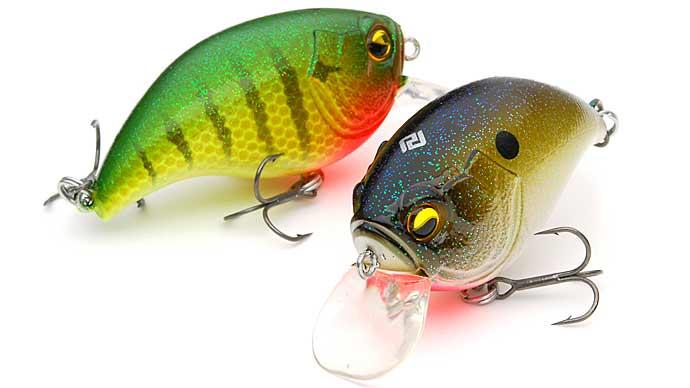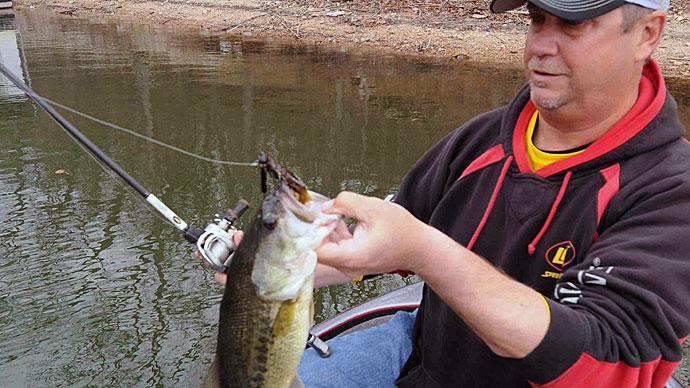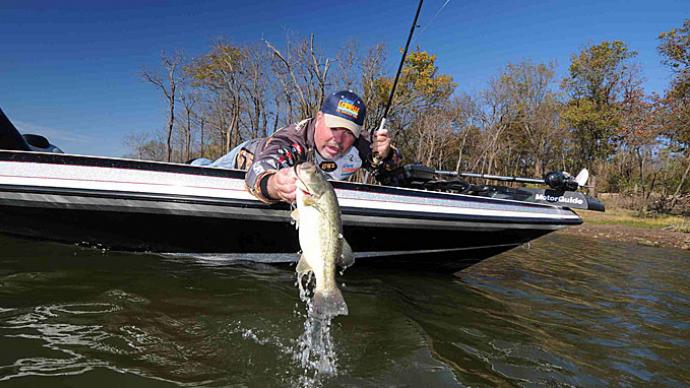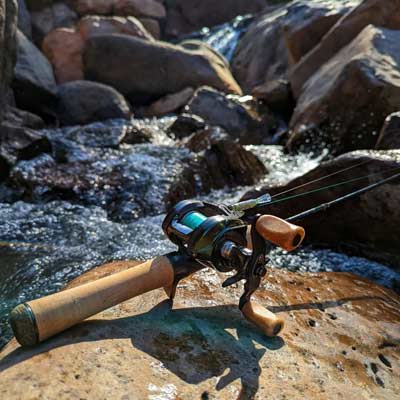
Japanese anglers often fish in limited waters that are highly pressured, so smaller baits and more finesse often get the nod. But that presents a problem: those small baits are almost impossible to throw using traditional baitcasting gear, and spinning gear often lacks the precision to put a tiny lure exactly where you want it.
Another drawback of spinning gear is line twist. The beauty of a baitcaster is that the line rolls straight off the reel and doesn't spool off as it does on a spinning rod. But unfortunately, this spooling action causes the dreaded spin caster line twist. So, between the inaccuracy, lack of power, and line twist, sophisticated Japanese anglers wanted baitcasting reels that would allow them to cast small lures like spinning gear without those inherent drawbacks.
So about ten or fifteen years ago, Japanese fishermen began tweaking their baitcasting reels with smaller spools.
Don Iovino was tournament-fishing with the mini Ambassadeurs and finesse lures with 5-lb mono in the 1990s, tuning his reels for light weights. BFS just didn't have a name yet.
The first reference to BFS in print was in 2000 when Hiroyuki Motoyama wrote about stream trout fishing. His books over the following decades on BFS were mostly aimed at shore bass fishing. The smartest guy in the world regarding BFS is Jun Sonada, who has put a lot of his experience into essays on his JapanTackle website.
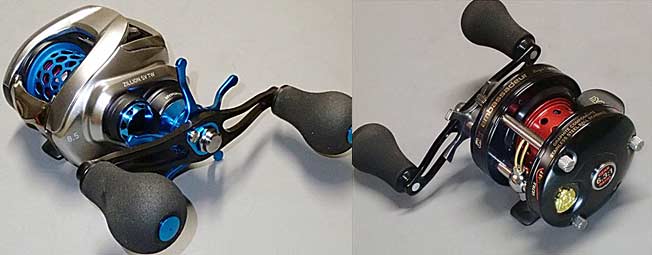
The first BFS reels were modified Ambassadeurs. Bait Finesse System combines a lighter-weight spool, low-inertia spool bearings (spool micro-bearings), and threadline that's either mono or PE braid about the diameter of #1 silk thread or 4-lb mono, give or take. It's baitcasting gear in the range of traditional ultralight spinning tackle.
The movement grew from there, and now you can get BFS rods and reels from online stores like Bait Finesse Empire. BFS reels are built small with shallow spools that allow light lures to pull the line out for casting.
Early in 2020, Gary Dobyns of Dobyn’s Rods posted on his Facebook page that he was toying with the idea of building a lighter power-fishing baitcast rod. Amir Azabbi, who had gotten into BFS via a small online community, answered Gary and suggested he build BFS rods. Gary had never heard of it, but he agreed.

He sent Azabbi and one other fisherman two rods, and they fished with them, tested them, and gave suggestions. At first, shops didn’t seem interested, so Azabbi started a shop himself (Bait Finesse Empire), and Gary supplied him with the rods. Dobyns told me he is amazed at how fast BFS fishing has taken off. Now Dobyns Rods makes the Sierra Ultra Finesse Casting Rod Series, and he tells me he can hardly keep them in stock.
Special Gear
We all know that baitcasting gear gives you more precision for better accuracy and control. That's why the Japanese anglers who started the system started tinkering with the smallest baitcasters they could find, putting even smaller-capacity spools on them and tweaking them until they could throw super small baits.

It began with the mini Ambassadeur reels for trout fishing but quickly moved into mid-frame Ambassadeurs for bass BFS. The Ambassadeur BFS spools are an ounce lighter than stock spools. On newer low-profile reels, BFS spools are typically 1/3 to 1/2 the weight of deep stock spools and made shallow to hold a tiny fraction of the deep-spool line capacity.
By keeping the total rotating mass as small as possible, the spool, the moving portion of the spool bearings, and the loaded line mass combine to keep the system inertia low, allowing BFS to cast ultralight lures a great distance - often exceeding the distance of equivalent spinning tackle. The result is high cast reliability with minimal braking force.
Aftermarket spools and spool micro-bearings (BFS Air bearings) are available for many reel models. Fishermen may have the option of converting their existing baitcast reel to BFS. A $90 spool and $20 bearings may be an option for some, whereas a $300 package reel might not be. Of course, you can always swap it back if you prefer.

Japan home-packaged BFS reels are most often built on compact-frame low-profile reels. They're ready to fish with lightweight shallow spools and spool micro-bearings. They’re often rated for lines smaller than PE#1 and designed with faster level wind pitch to prevent line dig with the smallest threadlines.
Companies like Tsurinoya, iFishband, Daiwa, and Shimano make specific BFS reels that are perfect for the Bait Finesse System. For instance, the Shimano Calcutta Conquest BFS HG 2017 has a 6.8:1 gear ratio that takes up 26.8 inches of line per handle turn. It holds just 49 yards of 8-pound-test line.
The BFS rods are specially designed with very light, limber tips to make casting the small baits easier. However, they aren't noodle rods – they tend to be pretty stout with a medium to medium-light action, so even though you can cast small lures when you get hooked up, you know you've got a true bass rod.
BFS is also hugely popular with trout fishermen, and the trout rods are generally shorter (4 to 5 /2 feet), ranging from moderate to extra-fast action (the latter for strong current) that is ideal for what the Japanese call "area fish," meaning stocked trout. In addition, these rods flex more when you cast than traditional bass gear, allowing you to play a trout slowly and keep it on the line.
BFS bass rods will typically handle lures as light as 1/8- to 1/16th ounce, while the trout rods will allow you to throw as light as 1/32 ounce. Over the past year, BFS has gone beyond a niche – this year, at ICAST, two or three American companies had BFS rods on display.

Every country with a fishing tradition has a history of threadline fishing using progressive-taper rods, which goes back to at least the advent of spinning reels. The Scot, Alexander Wanless, Ernest Schwiebert in the US, and, more recently, Joe Robinson and the late Dave Whitlock made their finesse rods from fly rod blanks. Centuries before the advent of reels, the Japanese did something similar with long rods and threadline, which they call Cara.
Finesse rods have a progressive taper, or what I call super-progressive. They're very close to the good dry-fly tapers in fly rods. They feature a short soft tip, long fast mid, and powerful butt. Shorter progressive tapers like Japanese stream trout rods aren't long enough to load deeper for big lures, but 1-7 g in a 5' rod is still a wide lure range. They're very different from traditional ultralight spinning rods, which are typically para tapers with narrow lure-weight range, and flexing deep into the rod butt. Even the light and ultralight stream trout rods feel fast and crisp. You're usually casting off the tip.
In recent years, the Japanese have been quickly adding salt-niche BFS rods that traditionally belong to finesse spinning tackle for rockfish, shore (surf) micro-jigging, offshore micro-jigging and inshore micro-plug, and soft jig fishing. These rods can have extreme lure ranges and big-fish power, especially as they go longer, e.g., 2 to 20 g and 3 to 30 g in all-range rods over 8'. The move to salt BFS makes sense. They've been eating there for 2000 years and using most all spinning rods there for a generation.

BFS rods over 7-1/2' are generally intended for shore fishing. Rods under 7-1/2' are mainly made for boat fishing. However, many lightweight, powerful shorter rods can double for all-range bass finesse.
Lures
BFS lures run the entire gamut of bass lures – from plastics to metal baits to plugs and topwater. Azzabi says that it isn't the size of the bait per se. Instead, the weight of the bait matters with BFS gear. If you start getting too heavy, you're better off with regular baitcasting gear.
You can fish many traditional bass baits with the Bait Finesse System – many worms are light enough, as well as small 1-1/2- to 2-inch craws and creature baits, 1- to 3-inch swimbaits, etc. However, Azzabi says hard baits are the most popular on his website: things like crankbaits, jerkbaits, etc. He imports many of them directly from Japan, as the Japanese have been doing this for a long time and have better quality spinnerbaits.
Topwater baits are one of his most significant selling categories, and BFS has about every kind you can think of, including Spook-like baits, poppers, and even floating soft baits. There are also frogs, inline spinners, and even spoons.
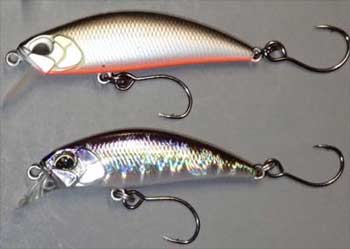
It’s worth noting about casting weightless plastics with BFS tackle - BFS makes it easy to cast a worm or swim jig without a weight. Many JDM suspending plastic minnow bodies are made to be fished with a single hook only. In addition, BFE offers various single-plug hooks.
When fishing these lures, a must-have item is the Smith Pinchette split ring tweezers for size 0 split rings. This allows you to take Japanese stream trout plugs with micro-trebles and swap larger single-plug hooks for bigger fish. These hooks foul on spinning line casts but seldom foul with BFS because of tight line casts. You can fish these for snook all winter to imitate glass minnows and all summer for river bass.
In addition to finesse plugs and spoons, one of my favorite river lures duplicates a Woolly Booger on a fly rod and bottom-bounces. BFE sells the Mukai Max inline spinner that keels hook-up. In addition, Vanfook offers the pre-tied woolly booger tail.
Why BFS?
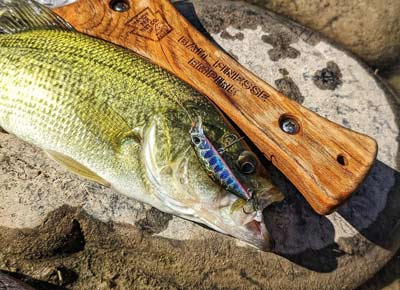
First, hooking a bass on gear this light is an incredible rush. It’s just plain fun. Azzabi says that for most guys (here in America, anyway), BFS isn’t going to be their primary bass fishing gear. It's going to be one part of what you do. So you can undoubtedly use your power stuff, but finesse will become more and more critical as pressure increases.
Amir has also seen many avid bass anglers getting into BFS because they love power fishing, but shoulder or other injuries have made it too difficult for them to use traditional heavy baitcasting gear all day. BFS is the ideal solution – much lighter, but supplies the need for speed!
If you like to fish in small rivers, creeks, and ponds, BFS is the way to go, especially if you walk the bank. Amir loves walking creeks for bass, getting away from other anglers, and enjoying the sport and the outdoors. Most of the fishing that a creek or pond fisherman does is shallow fishing, and that's ideal for BFS since the reels don't hold much line. However, you'll be better off with your big gear if you want to fish deep.
Some of the most popular BFS fishing rods on Bait Finesse Empire are the 4-piece travel rods. They break down small enough to fit in a day pack, so you can easily carry your gear anywhere. For example, Azzabi uses a fanny pack as a tackle box and only needs a couple of small boxes for all the lures he needs, plus pliers, etc.
He says that when you're fishing a creek that's only ten inches deep, you don't need much line out, so BFS is perfect for that because it still gives you the backbone to get a smallmouth out of current. And it's much easier to cast with a baitcaster when surrounded by trees and brush. He loves fishing Japanese minnow lures in creeks. They sink, so it's an aggressive bait, and you have to fish it with a fast twitch. He walks along the creeks and power fishes.
Amir also says he's seen many crappie fishermen getting into BFS, especially with the new Live View technology. It allows them to cast directly to the target. But, for bass fishermen, BFS is like Power Finesse Fishing. It lets you cover shallow water very quickly but with smaller baits. So it's ideal for pitching or flipping small baits just outside cover, for instance, but you probably wouldn't use it to pitch right INTO the cover.
BFS fishing is perfect for travel, particularly when you're not bringing a big bass boat. Imagine being able to pack a single-day pack with all the fishing gear you'll need! You can probably think of many places near you where the Bait Finesse System would be the ideal way to have a nice quiet day of fishing, so check out BFS – I bet you get hooked!
BassResource may receive a portion of revenues if you make a purchase using a link above.


